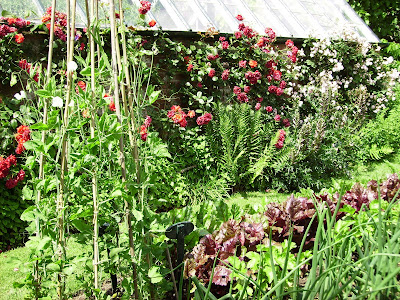I'm very good at acquiring plants. I'm really bad at sorting them out when I get home. In my garden, there's usually a row of evacuees, complete with metaphorical gas masks and labels round their necks, sitting on the step waiting to be assigned to a new home. If they're lucky, they get planted up in a pot. If they're unlucky, and need to go straight into the ground, then it's anyone's guess when I'll get round to digging a hole for them.
The trouble is, I usually have somewhere in mind for them, but when I get them back to the garden, I then change my mind about where they're going to go, or find that the pot that would be ideal already has something else in it that needs to be rehomed, and then while I'm wondering about that, I think I might see if there are any damselflies on the pond, or fill up the bird feeder and before you know it, it's next Wednesday.
Some of the time, my eyes are just bigger than my garden, and I come home with something that I really really want, but without a clue as to where it is going to go. This usually happens when I go to a really good nursery.
Visiting a good nursery is one of the great pleasures of gardening life. It's wonderful to wander round a fascinating selection of plants, to see something that makes your heart skip a beat, to spot something that you've never seen before, that you absolutely must have. You have the added bonus of expert knowledge, of talking to someone who has known that plant since it was a seed or a cutting, and is familiar with its funny little ways. And if that nursery has a garden attached, as Knoll Gardens, near Wimborne, in Dorset, do (see picture below), and the day on which you are visiting happens to be a gloriously sunny Saturday in June, then that's pretty much my idea of heaven.

Knoll Gardens (www.knollgardens.co.uk to order a catalogue or buy online) have won gold medals at the Chelsea for the past seven years. They specialise in grasses and perennials, but their Chelsea display is usually dominated by the grasses: lush clumps of miscanthus, arundo, equisetum, pennisetum and hakone, to name only a few. I'd picked up a catalogue at Chelsea and spotted something called Muhlenbergia dumosa, aka Bamboo Muhly,

which is a good name for it as it resembles a cross between a grass and a very delicate bamboo, with cane-like stalks and fine, feathery foliage. It's native to Arizona and Mexico, so it's drought-tolerant. It does well in a pot and looks fabulous with the sun shining through it. The Muhly was my heart-beats-faster plant, but I also bought some hakonechloa (Knoll do what they call starter, or smaller plants, which are useful for tucking into tight corners: three for £10) and some Sisyrinchium striatum 'Aunt May', to which, like hakone grass, I've become slightly addicted. What with the heatwave and my incipient sunburn, and the excitement of being in Dorset, which I love, I nearly lost my head and bought some Dianthus

carthusianorum. This is a fabulous dianthus, deep pink, with tall grassy stems, which would look great with grasses. It's incredibly elegant, like a 1950s fashion model, but with the simplicity and scale of a wild flower. Gorgeous. But I couldn't think where I would put it, so reluctantly left it for next time. (Front garden. Definitely.)





















